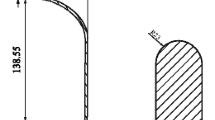Abstract
Due to the complex nature of sheet metal spinning processes, recent trends in analysis of the process are moving toward numerical techniques. These numerical methods, for instance finite element modelling, enable the study of parameters that can not easily be measured directly such as transient strains and stresses. Additionally, it allows a prediction of dynamic instabilities that may be used to control and achieve better product quality. In this investigation, a finite element dynamic explicit model has been used to simulate single and dual pass conventional spinning processes. The initial models are validated against published experimental data and show very good correlation. A variety of roller feed rates, roller passes and roller configurations are then simulated. Effects of roller feed rate on the axial force, radial force and thickness strain are established. The effect of roller pass and roller configuration on the axial force and thickness strain are also assessed.



















Similar content being viewed by others
References
Wong CC, Lin J, Dean TA (2005) Effects of roller path and geometry on the flow forming of solid cylindrical components. Journal of Materials Processing Technology 167(2–3):344–353
Brown J (1998) Advanced Machining Technology Handbook. McGraw-Hill, US
Quigley E, Monaghan J (2002) The finite element modelling of conventional spinning using multi-domain models. Journal of Materials Processing Technology 124(3):360–365
Liu C-H (2007) The simulation of the multi-pass and die-less spinning process. Journal of Materials Processing Technology 192–193:518–524
Long H, Hamilton S (2008) Simulation of effects of material deformation on thickness variation in conventional spinning. 9th International Conference on Technology of Plasticity. 9th International Conference on Technology of Plasticity, Gyeongju
Hamilton S, Long H (2008) Analysis of conventional spinning process of a cylindrical part using finite element methods. Proceedings of the 12th International Conference on Metal Forming. Kraków, Poland, Steel Research International, Special Edition 79(1):632-639
Zhan M, Yang H, Zhang JH, Xu YL, Ma F (2007) 3D FEM analysis of influence of roller feed rate on forming force and quality of cone spinning. Journal of Materials Processing Technology 187–188:486–491
Qian B, He Y, Mei Z (2008) Finite element modelling of power spinning of thin-walled shell with hoop inner rib. Transactions of Nonferrous Metals Society of China 18(1):6–13
Liang H, He Y, Mei Z, Li-Jin H (2008) Numerical simulation of influence of material parameters on splitting spinning of aluminium alloy. Transactions of Nonferrous Metals Society of China 18(3):674–681
ABAQUS, Inc (2007) ABAQUS User Manuals, Version 6.7, United States of America
Wong CC, Dean TA, Lin J (2004) Incremental forming of solid cylindrical components using flow forming principles. Journal of Materials Processing Technology 153–154:60–66
Xia Q, Shima S, Kotera H, Yasuhuku D (2005) A study of the one-path deep drawing spinning of cups. Journal of Materials Processing Technology 159(3):397–400
Kalpakjian S, Schmid S (2001) Manufacturing Engineering and Technology. Prentice Hall Intern, London
Quigley E, Monaghan J (2000) Metal forming: an analysis of spinning processes. Journal of Materials Processing Technology 103(1):114–119
Akkus N, Kawahara M (2006) An experimental and analytical study on dome forming of seamless Al tube by spinning process. Journal of Materials Processing Technology 173(2):145–150
Acknowledgment
The authors are grateful to acknowledge the financial support provided through the UK ORSAS Scheme.
Author information
Authors and Affiliations
Corresponding author
Rights and permissions
About this article
Cite this article
Essa, K., Hartley, P. Numerical simulation of single and dual pass conventional spinning processes. Int J Mater Form 2, 271–281 (2009). https://doi.org/10.1007/s12289-009-0602-x
Received:
Accepted:
Published:
Issue Date:
DOI: https://doi.org/10.1007/s12289-009-0602-x



